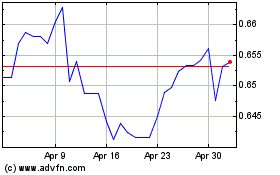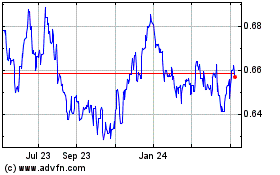U.S. Dollar Falls On Fed Rate Cut Hopes As Inflation Slows
April 28 2019 - 11:34PM
RTTF2
The U.S. dollar came under pressure against its most major
counterparts in the Asian session on Monday, as expectations for a
Fed rate cut increased after last week's GDP data showed that a
gauge of inflation slowed from the previous quarter.
Although the U.S. economy grew much faster than forecast in the
first quarter, Federal Reserve's preferred inflation measure, the
core PCE price index, slowed notably.
The data showed that core consumer prices, which exclude food
and energy prices, slowed to 1.3 percent in the first quarter from
1.8 percent.
Investors await the Fed's two-day meeting concluding on
Wednesday.
No rate change is expected, but the accompanying statement and
Fed Chairman Jerome Powell's subsequent press conference are likely
to attract attention.
This week's U.S. economic calendar includes reports on jobs,
personal income and spending, consumer confidence, pending home
sales, manufacturing and service sector activity.
The greenback declined to 1.2940 against the pound, compared to
last week's closing value of 1.2910. The greenback is poised to
find support around the 1.32 level.
The greenback edged down to 1.0187 against the Swiss franc early
in the session and held steady thereafter. The pair finished last
week's deals at 1.0196. Next key support for the greenback is
likely seen around the 0.99 level.
After rising to 1.1145 against the euro at 9:30 pm ET, the
greenback reversed direction and slipped to 1.1166. The greenback
is likely to find support around the 1.135 region, should it falls
again.
The greenback fell to 0.7061 against the aussie and 0.6681
against the kiwi from Friday's closing values of 0.7036 and
0.6656,respectively. The next possible support for the greenback is
seen around 0.73 against the aussie and 0.68 against the kiwi.
On the flip side, the greenback advanced to 111.73 against the
yen and 1.3465 against the loonie, from its early low of 111.54 and
a 5-day low of 1.3450, respectively. On the upside, 113.00 and 1.36
are possibly seen as the next resistance levels for the greenback
against the yen and the loonie, respectively.
Looking ahead, Eurozone economic sentiment index for April is
due in the European session.
In the New York session, U.S. personal income and spending data
for March are set for release.
AUD vs US Dollar (FX:AUDUSD)
Forex Chart
From Mar 2024 to Apr 2024

AUD vs US Dollar (FX:AUDUSD)
Forex Chart
From Apr 2023 to Apr 2024
